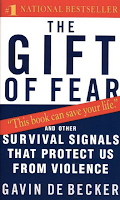 |
| Image courtesy clubrunwithus.com. |
Among the information that has come to light in the last few days was the fact that the innocent children and adults who were slaughtered two days ago were shot with guns owned by Adam Lanza’s mother–and murder victim–Nancy. This is one more data point consistent with the bulk of peer reviewed research confirming that gun ownership, and keeping guns at home, significantly increases the odds of household members dying of accidents, suicide, and homicide.
The hoarse calls for Second Amendment freedoms, and the ludicrous suggestions that teachers keep guns in the classroom “for protection”, I set aside here. I find them tasteless, misinformed, and impossible to reasonably interact with. But I do want to express some surprise not at private citizens and internet commenters, but at situational crime prevention criminologists. For all the advice on how to make crime more difficult to commit, not a word about gun control?
I learned about situational crime prevention in the early 2000s from David Weisburd, one of the world’s foremost experts on it. After learning many lofty theories about the etiology of crime in grad school–free choice, medical pathology, difficult childhood, racism, patriarchy, deprivation, labeling, strain–there was something almost disappointing about delving into a theory that advocated keeping CDs locked behind the counter at the record store, displaying only one shoe of a pair at the sports store to prevent theft from the shelves, and placing armrests on park benches to prevent homeless people from sleeping on them. Figuring out why people commit crime is a big enterprise, said David at the time; “crime” is a general name for a family of diverse and unrelated phenomena, and there is no shame in manipulating the non-offender factors to reduce its occurrence.
In grad school, and as a postdoc, I confess I looked down on this literature, but I’ve since become wiser and grateful for the time I got to spend with David and read this stuff. Having done some fieldwork on open drug markets, I’ve realized that even the most constrained situations–rife with social inequalities, municipal indifference, and racial injustices–offer offenders some measure of rational choice, however confined it might be. Even within the tough and distressing realities of the Tenderloin drug market, drug traffickers sell their merchandise not under the private SRO surveillance cameras, but away from there, near the municipal cameras they know don’t work. I don’t really buy Ron Clarke’s adherence to rational choice as the principal model explaining human behavior–I find its poverty disturbing–but denying agency and ascribing everything to social ills is equally disturbing and simplistic. To some extent–when done in concert with an effort to understand more deeply what is going on–manipulating the environment to make crime less appealing or more difficult to commit is not a bad idea. Displacement is a problem, of course, but that can be addressed, as David Kennedy reminds us, with tough enforcement at “hot spots”.
But for all the grants, contracts, and consulting that situational crime prevention experts do, their efforts are mostly addressed at quality of life crime and at property crime. Take a look at the advice offered on the Center for Problem-Oriented Policing website, for instance, and click on all the squares. It is geared toward vandalism and petty theft. I expected to see a word about gun control in their “control tools and weapons” tab. Instead, we are told to manufacture “smart guns” and to restrict spray-paint sales to juveniles.
Spray-paint sales?
I think what is happening here is that criminologists who have been dealing with municipalities and police departments don’t want to rock the boat. The minute they make recommendations that might require someone, God forbid, to appear to be pro-regulation or what Americans mistakenly refer to as “socialist”, police chiefs and politicians will stop listening. Sit-lie ordinances, or making benches uncomfortable, do not make politicians tremble. But take something on which there is basically a professional consensus – more easily obtained guns mean more deaths – and everyone is suddenly very quiet.
I want my friends who have given such excellent advice to retailers and housing project managers (I say this with appreciation and admiration, and without a shred of cynicism) to grow a backbone and tell the people who work with them that some government regulation might be necessary. If they are genuine in stating that situational crime prevention is wholly apolitical, and not merely an incarnation of criminological conservatism, isn’t this a good time to argue for gun control? I want my friends to do more than quality-of-life architecture. Research is on their side. All it takes is for one respected scholar in the prevention field, not a shrill-voiced lefty, to say words of reason and science. Who is it going to be?








